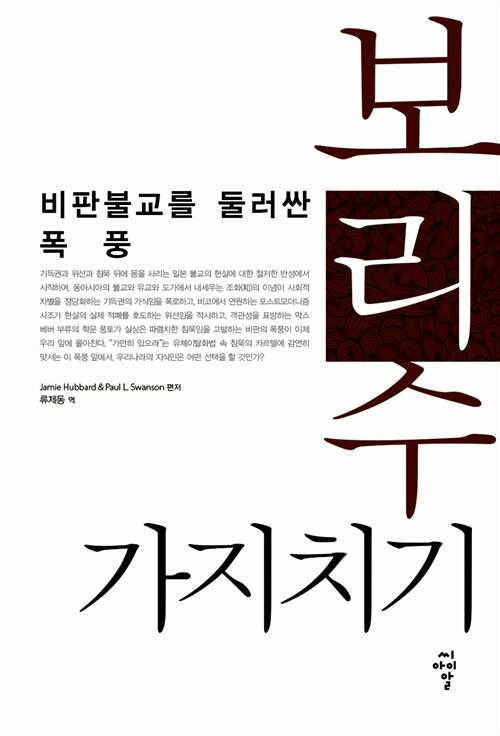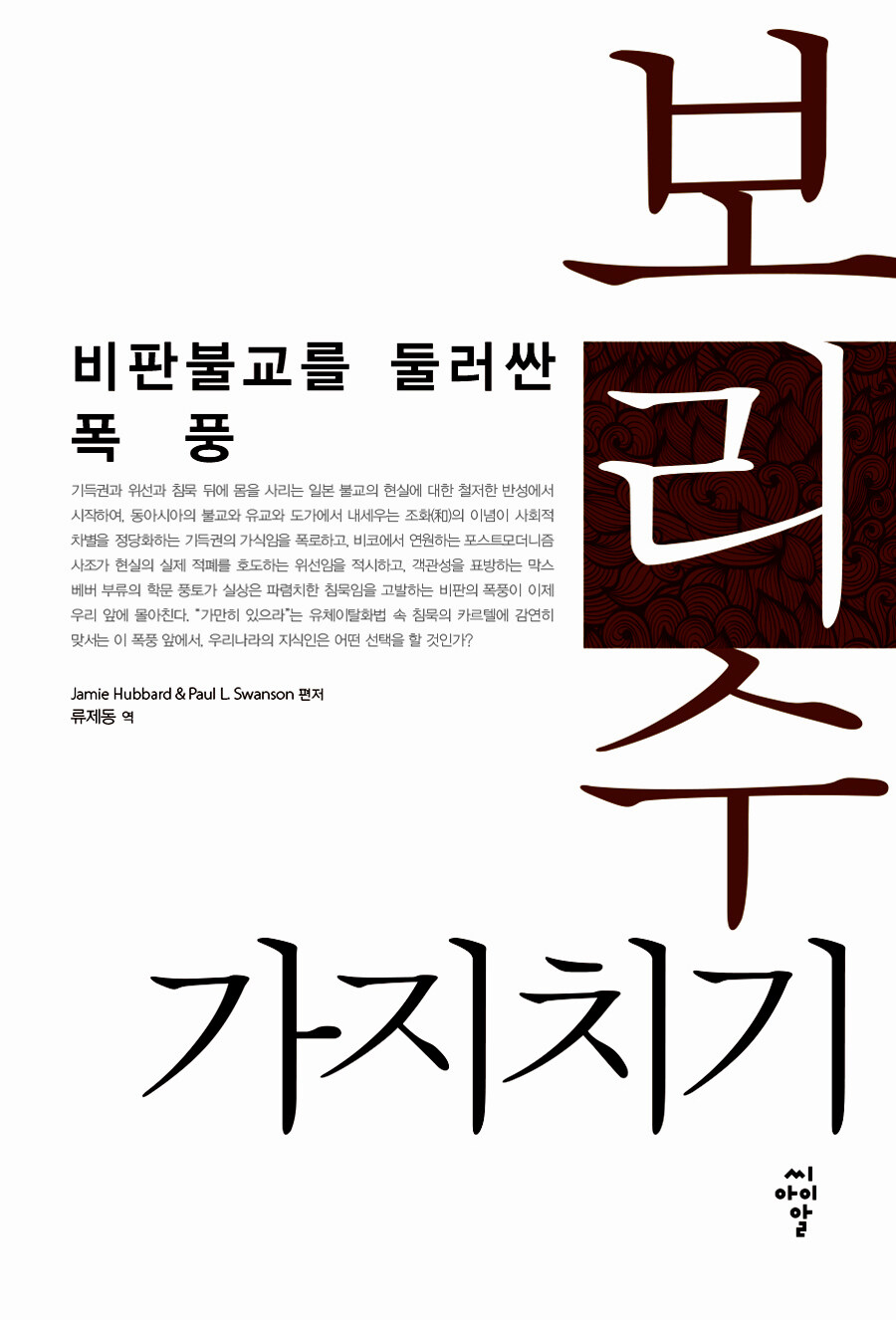Pruning the Bodhi Tree: The Storm Over Critical Buddhism
by Jamie Hubbard (Editor), Paul L. Swanson (Editor)



비판불교를 둘러싼 폭풍
제이미 허바드, 폴 스완슨 (지은이), 류제동 (옮긴이) CIR(씨아이알) 2015-06-05
정가
38,000원

10
100자평 1편
리뷰 1편
세일즈포인트 117
776쪽
책소개
오늘날의 불교학자를 비롯한 인문학자들은 참여적이고 양심적이고 실천적인 지혜에 대한 사랑을 포기하고, 기득권층의 정의롭지 못한 질서에 편승하면서, 더 나아가 기꺼이 종속적으로 자본을 추종하면서, 우리의 몸을 상하게 하는 불량식품보다 더 심각하게 우리의 정신을 좀먹는 어용 지식을 판매하는 지식소매상 노릇을 자처하고 있으면서도 전혀 부끄러움을 느끼지 못하고 있지 않은가?
여기에 하카마야 노리아키 그리고 마츠모토 시로 같은 일본의 대표적 불교학자들이 그 지혜의 나무를 되살리고자 본격적인 가지치기에 나섰다. 오늘날 그 가지치기 작업은 ‘비판불교운동’이라는 하나의 거대한 운동으로 확산되어 전개되면서, 불교학계를 넘어서 지구촌의 학계 전반을 강타하는 폭풍이 되어 몰아치고 있다.
목차
추천사
편저자 서문
역자 서문
서 론-제이미 허바드
제1부 비판불교란 무엇이며 왜 주창되는가?
1. 왜 선은 불교가 아니라고 이야기되는가?
2. 비판불교와 근원으로의 회귀
3. 비판철학 대 장소철학
4. 장소 공포증
5. 비판으로서의 학문
6. 비판의 한계
7. 비판불교에 대한 코멘트-마츠모토 시로
제2부 참된 불교를 찾아서
8. 여래장사상은 불교가 아니다
9. 불성사상은 온전히 불교적이다
10. 유가행파와 여래장 문헌에서 기체설 사상
11. 기체설 사상에 관한 비판적 대론(對論)
12. 티벳으로 도입된 인도불교의 핵심 요소들
13. ‘선’(禪)의 의미
14. 비판불교와 도겐의 『정법안장(正法眼藏) 』
15. 비판불교는 실제로 비판적인가?
16. 형이상학, 고통, 그리고 해방
17. 기체설과 불교학의 최근 동향에 대한 고찰
18. 비판불교에 대한 재검토
제3부 사회비판
19. 사회적 차별의 이념적 배경에 대한 고찰
20. 불교와 가미
21. 천태본각사상과 일본의 자민족중심주의적 전환
22.『법화경 』과 일본문화
접기
저자 소개
지은이: 제이미 허바드
저자파일 신간알리미 신청
최근작 : <보리수 가지치기> … 총 2종 (모두보기)
스미스 대학(Smith College) 예한 누마타좌(Yehan MumataChair) 불교학 교수. “야마구치 이야기: 현대일본에서 불교와 가족”(“The Yamaguchi Story: Buddhism and the Family in Contempororay Japan,” British Broadcasting Corporation, 1988)이라는 비디오를 연출했으며, 『절대적 망상, 완벽한 성불:한 중국불교 이단의 흥기와 몰락』(Absolute Delusion, Perfect Buddhahood: The Rise and Fall of a Chinese Heresy, Univ of Hawaii Press, 2000)의 저자
접기
지은이: 폴 스완슨
저자파일 신간알리미 신청
최근작 : <보리수 가지치기> … 총 2종 (모두보기)
난잔 종교문화연구소(南山 宗敎文化硏究所) 상임연구원이자 난잔대학(南山大學) 교수. 『일본종교학 저널』(Japanese Journal of Religious Studies)의 편집자이자 『천태 철학의 토대』(Foundations of T’ien-tai Philosophy, Asian Humanities Press, 1989)의 저자
접기
옮긴이: 류제동
저자파일 신간알리미 신청
최근작 : <종교와 정의>,<재미있는 지구촌 종교 이야기>,<종교 간의 대화> … 총 11종 (모두보기)
비교학문적 시각에서 불교에 접근하는 연구자이다. 2004년 서강대학교 종교학과에서 박사학위를 받았다. 서강대학교, 성균관대학교, 가톨릭대학교, 금강대학교, 위덕대학교, 중앙대학교, 한신대학교, 그리고 신앙인아카데미 등에서 강의하였다. 한국과 일본에서 불교의 사회참여와 현대적 이해, 서구권에서 현대 불교의 재구성 등에 관심을 가지고 연구하고 있다. 『하느님과 일심: 윌프레드 캔트웰 스미스의 종교학과 대승기신론의 만남』, 『보리수 가지치기: 비판불교를 둘러싼 폭풍』, 그리고 Catastrophe and Philosophy(공저) 등의 저역서가 있다.
접기
출판사 제공 책소개
불교학계를 넘어 인문학계 전반에 가지치기를 시도하는 비판의 폭풍
보리수로 상징되는 불교전통은 오늘날 양심적으로 지혜의 나무 역할을 제대로 하고 있는가? 더 나아가, 불교전통을 넘어서 오늘날의 문학, 사학, 철학, 종교학을 아우르는 인문학은 양심적으로 지혜의 나무 역할을 제대로 하고 있는가? 지혜의 나무는 이미 병들어서 고사(枯死)하고 있지 않은가?
오늘날의 불교학자를 비롯한 인문학자들은 참여적이고 양심적이고 실천적인 지혜에 대한 사랑을 포기하고, 기득권층의 정의롭지 못한 질서에 편승하면서, 더 나아가 기꺼이 종속적으로 자본을 추종하면서, 우리의 몸을 상하게 하는 불량식품보다 더 심각하게 우리의 정신을 좀먹는 어용 지식을 판매하는 지식소매상 노릇을 자처하고 있으면서도 전혀 부끄러움을 느끼지 못하고 있지 않은가?
여기에 하카마야 노리아키 그리고 마츠모토 시로 같은 일본의 대표적 불교학자들이 그 지혜의 나무를 되살리고자 본격적인 가지치기에 나섰다. 오늘날 그 가지치기 작업은 ‘비판불교운동’이라는 하나의 거대한 운동으로 확산되어 전개되면서, 불교학계를 넘어서 지구촌의 학계 전반을 강타하는 폭풍이 되어 몰아치고 있다.
기득권과 위선과 침묵 뒤 일본 불교의 현실에 대한 철저한 반성에서 시작하여, 동아시아의 조화(和)의 이념이 사회적 차별을 정당화하는 기득권의 가식임을 폭로하고, 객관성을 표방하는 막스 베버 부류의 학문 풍토가 실상은 몰염치한 침묵임을 고발하는 비판의 폭풍이 이제 우리 앞에 몰아친다. 이 폭풍 앞에서, 한국의 지식인은 어떤 선택을 할 것인가?
접기
1
100자평
1
리뷰
0
마이페이퍼
읽고 싶어요 1명
읽고 있어요 0명
읽었어요 3명
구매자 분포

0% 10대

2.6%

5.1% 20대

0%

10.3% 30대

7.7%

5.1% 40대

20.5%

12.8% 50대

17.9%

5.1% 60대

12.8%
여성 남성
100자평
게시물 운영 원칙


카테고리

현재 0/280byte (한글 140자 이내)
스포일러 포함
등록
구매자 (0)
전체 (1)
tvam 2015-07-14
˝불자(佛子)는 일본을 사랑해서는 안 된다˝ - 『보리수 가지치기』 548쪽. 일본의 대표적 불교학자가 이렇게 주장합니다. 배신 운운하는 누군가와는 차원이 다른 사람이 특히 일본에 있다는 것이 가슴 아픕니다.
공감 (1) 댓글 (0)


마이리뷰
쓰기
구매자 (0)
전체 (1)

tvam 2015-06-26
피터 그레고리, 폴 그리피스, 루벤 하비토, 스티븐 하이네, 제이미 허바드, 샐리 킹, 댄 러스트하우스, 폴 스완슨, 람버트 슈미트하우젠,린쩐구어, 하카마야 노리아키, 마츠모토 시로, 스에키 후미히코, 다카사키 지키도, 야마베 노부요시, 야마구치 즈이호, 다무라 요시로, 히라카와 아키라 등, 구미와 중국 및 일본의 석학들이 불교의 미래를 넘어, 종교와 인류의 미래에 관하여 격론을 전개합니다.
영화 <관상>에서 한명회에 대한 김내경의 명대사...파도만 보았을뿐 바람을 보지 못했소...파도를 만드는것은 바람인데..
https://www.youtube.com/watch?v=0w9thT-ay7M#t=14
如大海水,因風波動,水相風相不相捨離.
바다의 물은 바람으로 인해 파도가 되어 움직인다.
그러므로 파도의 상은 바람의 상과 따로이 떼어 놓을 수가 없다.
- 대승기신론(大乘起信論)-
파도를 만드는 바람이란 『대승기신론(大乘起信論)』의 핵심인 “소언법자, 위중생심(所言法者, 謂衆生心)”의 중생심, 곧 민중의 마음입니다. 『보리수 가지치기』에서 바로 그 민중의 마음을 둘러싼 치열한 논쟁이 전개됩니다.
“일본에는 어떠한 형태의 사회적 차별도 존재하지 않는다.” 1979년 세계종교평화회의(World Conference on Religion and Peace)에서 당시 일본 조동종 종무총장이자 전일본불교회 이사장이었던 마치다 무네오(町田 宗夫)의 이러한 발언에 대한 뼈아픈 반성에서 일본의 비판불교운동이 전개되어 세계적으로 확산됩니다. 유체이탈화법 속 침묵의 카르텔이 횡행하는 한국의 현상황에서 이렇게 철저한 반성 운동이 특히 절실하게 느껴집니다. 2011년 우리나라 전임 대통령의 “(우리는) 도덕적으로 완벽한 정권”이라는 유체이탈화법식 발언이 연상됩니다. 일본에서 이렇게 철저한 반성 운동이 전개되고 있다는 것이 놀랍고, 아직 그러한 반성의 기미조차 보이지 않는 우리나라의 현실이 부끄럽기도 합니다.
불교란 무엇인가? 하카마야 노리아키와 마츠모토 시로는 선불교에서 그 답을 찾지 말라고 합니다. 교토학파 철학에서 가르치는 불이(不二)에서도 찾지 말라고 합니다. 하카마야는, 기성 불교 전통에서 진리에 관한 언표 가능성 자체가 부정되고 언어적 표현과 합리적 사고가 저해됨으로써 불교적 실천과 사회정의의 심장, 곧 진리에 대한 비판적 식별이 소실되기에 이르렀다고 비판합니다.
저명한 불교학자 가마타 시게오(일본 도쿄대학 불교학 명예교수)는 이 책에 대하여 “본각사상 비판에 관한 이 글들이 현대사상계 전반에 그리고 구체적으로 불교학계에 혁명적 충격을 가하리라 확신한다. 이 책은 참된 불교가 무엇인가를 당신에게 말해준다.”라고 이야기합니다.
세계적인 종교학자 존 F. 키난(미국 미들베리 대학교 종교학 교수) 또한 다음과 같이 이 책의 중요성을 이야기합니다.
“하카마야 노리아키와 마츠모토 시로의 비판은 순응적이고 무비판적인 관념과 관행에 대한 직접적 도전이다. 이 책이 출간됨으로써, 일본에서만이 아니라 불교가 가르쳐지고 실천되는 곳 어디에서나 중요한 그 이슈들이 서구의 독자들과 조우한다.”
공감 (2) 댓글 (0)








